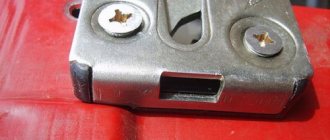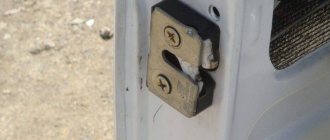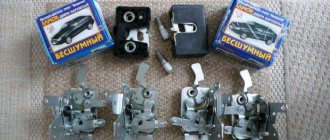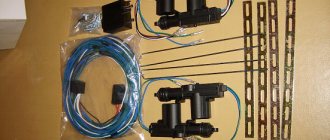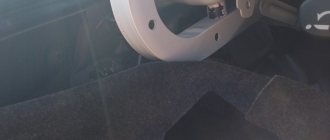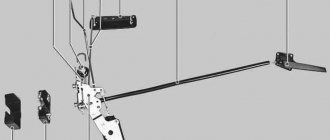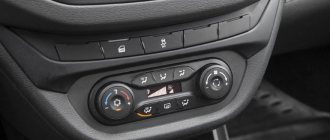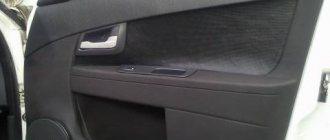Not all owners of domestic cars like the unpleasant, loud clicking sound made by their locks when locked. Therefore, they often wonder: how to eliminate this annoying defect?
In this article we will tell you in detail how to make silent locks on a Priora with your own hands to ensure maximum comfort. The main reason for the clanging lies in the locking shackle, which is adjacent to the metal of the case. Silent mechanisms are assembled from elements made of polymers that do not vibrate.
It should be noted that Priora already leaves the assembly line with locks that use the main components with plastic inserts and bolts with silicone seals. However, despite all this, closing the door is still accompanied by a loud metallic click.
It is important to remember that installing or modifying a locking device is always accompanied by replacing the door seal with a better one. This allows you to simultaneously enhance the sound insulation of the cabin.
Where to get a silent lock
These devices suitable for Priora are easy to purchase:
- in specialized online stores;
- at the car market;
- at specialized retail outlets.
Which ones are better to buy? To reduce the hassle of installation, we advise you to look for original locks made specifically for this model produced by the Volzhsky Automobile Plant.
How much do locking devices cost? In particular, a set of four mechanisms equipped with anthers will currently cost only 750 rubles.
This option is made quite well and is free from the main drawback - clanging.
What you should know
Domestic cars mainly have locks of the so-called figure-eight design. Actually, Priora is no exception. The above-mentioned products have one distinctive feature - in the mating part of the device, the diameter of the screws is smaller than on the original mechanism.
Each bolt is provided with a silicone gasket. Unfortunately, it is impossible to choose their color, since the manufacturer did not provide such an option. As practice shows, the most popular option is transparent seals. However, this is an insignificant problem that only pathological perfectionists will not be able to come to terms with.
Do purchased locks need to be modified? As a rule, no. But some car enthusiasts replace the springs in the mechanism because they believe that the original ones are not tight enough. In addition, the bolt is often equipped with an additional noise-absorbing pad made from a heat-shrinkable tube of suitable diameter. However, many admit that such an improvement is not particularly effective.
A pattern that is the norm
The figure-of-eight design of locks is the norm in domestic car manufacturers. Priora was no exception to this rule and received figure-eight locks from the assembly line. What exactly is the pattern?
The pattern appears at the time of purchase of the above-mentioned silent locks, which also have a figure-eight design. The only difference is the smaller thread diameter of the bolts in the mating part of the mechanism.
All Ptimash bolts have a silicone seal, the color range of which cannot be predicted. It is worth paying attention to the fact that their color can be either transparent, which is the most popular, or any other. Thus, it is not realistic to match the color of your fingers to the color of the car, but the final high-quality result more than covers this shortcoming.
Preparing for installation
It is worth understanding that a lock is a mechanism designed to perform basic functions for a long time without fail and reliably protect the car from unauthorized entry. In addition, the specific nature of the placement makes it quite vulnerable to a number of negative factors. This means:
- high humidity;
- heat;
- freezing;
- dust, etc.
Therefore, before inserting the lock into the door, it must be thoroughly lubricated with a special compound. Along the way, it’s also worth processing:
- door handles;
- limiters;
- loops;
- internal constipation.
Prior door lock mechanism
We carry out the work when replacing the lock, its cylinder mechanism and the outer door handle. Remove the front door trim (see “Removing the front door trim”).
Use a slotted screwdriver to disconnect the rod from the cylinder mechanism of the lock.
Use a slotted screwdriver to pry up the mounting bracket for the cylinder lock mechanism...
...and remove the bracket.
We take out the cylinder lock mechanism along with the rubber sealing ring. Disconnect the lock rod from the outside door handle.
Using a 10mm socket, unscrew the two nuts securing the outer door handle...
...and remove the handle.
Using a slotted screwdriver, unfasten the clamp securing the wiring harness of the electric locking drive.
By pressing the latch... ...we disconnect the wiring harness blocks of the electric locking drive.
Using a Phillips screwdriver, unscrew the three screws securing the base of the inner handle...
...and the screw for securing the internal lock. We remove the external lock (see “Removing the external door lock”).
We remove the internal lock of the front door with rods and an electric drive for locking the lock through the technological opening of the internal door panel.
Front door lock with electric locking, external and internal door handles
Use a slotted screwdriver to disconnect the rod end of the outer handle from the lock lever.
In the same way we disconnect the rod of the cylinder mechanism of the lock.
Using a slotted screwdriver, we open the spring bracket that secures the rod of the inner handle...
...and remove the bracket. There is a spring washer under the bracket; remove it, and then the rod.
Using a slotted screwdriver, press out the plastic locking rod lock of the lock button, turning the lock around its axis.
In the same way we remove the locking electric drive rod.
Using a Phillips screwdriver, unscrew the two self-tapping screws securing the electric drive to the lock bracket and remove the electric drive.
We remove the rod from the hole in the electric drive rod of the lock.
Front door internal lock mechanism
We install the internal door lock, the lock cylinder mechanism and the external door handle in the reverse order.
Source: zinref.ru
Lock installation
To install a new locking mechanism, you will need to remove the trim from the car door. This will take a lot of time, but it will be possible to carry out a preventive inspection of other systems located in it.
In addition, you can use a knitting needle or a hairpin of sufficient length if you don’t want to bother with the sheathing. Then the inner part of the mechanism, put on it, will not fall inward when the outer one is dismantled.
The new element is installed in place. To do this, it is strung on a stud and secured with a bolt from below. Then the knitting needle is lifted and the upper fastener is screwed in. The rest of the locking devices on other doors are installed in the same way.
As you can understand, this procedure is not at all complicated - almost any car enthusiast with minimal skills can handle it.
If necessary, upon completion of installation, adjust the mechanism. The last thing required is to replace the protective plastic housing.
Removing the interior lock, lock cylinder and outer front door handle
We carry out the work when replacing the lock, its cylinder mechanism and the outer door handle.
Remove the front door trim (see “Removing the front door trim”). Use a slotted screwdriver to disconnect the rod from the cylinder mechanism of the lock.
Use a slotted screwdriver to pry up the mounting bracket for the cylinder lock mechanism...
...and remove the bracket.
We take out the cylinder lock mechanism along with the rubber sealing ring. Disconnect the lock rod from the outside door handle.
Using a 10mm socket, unscrew the two nuts securing the outer door handle...
...and remove the handle.
Using a slotted screwdriver, unfasten the clamp securing the wiring harness of the electric locking drive.
By pressing the latch... ...we disconnect the wiring harness blocks of the electric locking drive.
Using a Phillips screwdriver, unscrew the three screws securing the base of the inner handle...
...and the screw for securing the internal lock. We remove the external lock (see “Removing the external door lock”).
We remove the internal lock of the front door with rods and an electric drive for locking the lock through the technological opening of the internal door panel.
Front door lock with electric locking, external and internal door handles
Use a slotted screwdriver to disconnect the rod end of the outer handle from the lock lever.
In the same way we disconnect the rod of the cylinder mechanism of the lock.
Using a slotted screwdriver, we open the spring bracket that secures the rod of the inner handle...
...and remove the bracket. There is a spring washer under the bracket; remove it, and then the rod.
Using a slotted screwdriver, press out the plastic locking rod lock of the lock button, turning the lock around its axis.
In the same way we remove the locking electric drive rod.
Using a Phillips screwdriver, unscrew the two self-tapping screws securing the electric drive to the lock bracket and remove the electric drive.
We remove the rod from the hole in the electric drive rod of the lock.
Front door internal lock mechanism
We install the internal door lock, the lock cylinder mechanism and the external door handle in the reverse order.
Before installing the door trim, we check the functionality of the door lock mechanism. If the outer door handle or lock cylinder mechanism does not work correctly, the length of the rod should be adjusted by rotating the plastic tip of the rod.
Source: wiki.zr.ru
Other nuances
Knowledgeable people answer the question “Which are the best locks to take?” They answer that the quality of the purchased ones is not much better than the original ones, and they advise installing mechanisms from the Gazelle. True, here you will need to sharpen your tongue a little. But reviews indicate that the result in this case is simply wonderful.
To modify your original castle, you will need:
- install a foam rubber gasket between its mechanism and the door;
- cover the drive pin that opens the lock with heat-shrinkable tubing;
- fill the voids on the back of the mechanism - any sealant will do;
- the lower edge of the door is equipped with a seal (ideal option - RKI-19).
How to replace a door lock cylinder on a Lada Priora
The doors on the Lada Priora have a similar design as in the VAZ family of models 2110, 2111, 2112. The new Priora have a fairly hard (not crushed) door seal. Consequently, the doors in the Lada Priora generally close quite tightly, and also poorly and often have to be slammed several times. For example, on a 2- or 3-year-old car, the doors close much easier due to a dented seal, since the latter gets crushed after a while during frequent opening/closing, and, accordingly, the door slams much easier than on a new car.
Note. The well-known Vaseline is a good remedy for lock freezing in winter. It is worth using it as a lubricant, and your door will open freely with the key.
You can try the following option. You have purchased a new Lada Priora car. Close the windows and doors in it, then you need to close, for example, the rear right or left door (it doesn’t matter whether the door slams tightly or does not close the first time). Next, you need to open any door or lower the auto glass on the door (any) and you can slam it. The door should close much easier, since the air that enters the door during closing penetrates into the interior of the car. With the doors tightly locked, the flow of forced air cannot escape anywhere (in addition, a new seal). So, the door seems to be thrown back, as if something is preventing it from closing. Meanwhile, the Lada Priora, as well as foreign cars, has an air exhaust system. The latter catches up when the door is closed.
Sometimes the lock cylinder gets damaged, and then you have to replace it. On the Lada Priora, the larvae are changed in rare cases, since the majority of car owners almost never resort to closing the door mechanically. Mostly Prior owners use a standard key fob that locks and/or unlocks the door lock. However, situations cannot be ruled out when the key fob does not work, the driver has lost it, etc. In such a case, the owner of a Lada Priora is forced to use the cylinder in the door. If this part fails, to replace it you will need:
- pliers or long-nose pliers;
- a screwdriver with a flat blade;
- own new cylinder and keys.
How to care for locks
First of all, care should be taken to ensure that no water gets inside. This usually happens during the car wash process. In winter, moisture in the mechanism can freeze and then it is difficult to get inside the car. It is not difficult to avoid this - it is enough to regularly treat the external parts with silicone lubricant made in the form of a spray.
In addition, approximately 4 times a year, it is necessary to lubricate the internal parts of the locking device - this allows all elements to operate smoothly and extend their service life.
